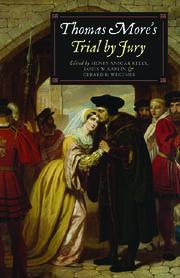Book contents
- Frontmatter
- Contents
- List of Contributors
- Preface
- Abbreviations
- Chronology
- 1 A Procedural Review of Thomas More's Trial
- 2 Natural Law and the Trial of Thomas More
- 3 A Guide to Thomas More's Trial for Modern Lawyers
- 4 Thomas More's Three Prison Letters Reporting on His Interrogations
- 5 Judicial Commentary on Thomas More's Trial
- Appendix 1 Documents
- Appendix 2 Thomas More's Trial: Docudrama
- Bibliography
- Index
1 - A Procedural Review of Thomas More's Trial
Published online by Cambridge University Press: 05 February 2013
- Frontmatter
- Contents
- List of Contributors
- Preface
- Abbreviations
- Chronology
- 1 A Procedural Review of Thomas More's Trial
- 2 Natural Law and the Trial of Thomas More
- 3 A Guide to Thomas More's Trial for Modern Lawyers
- 4 Thomas More's Three Prison Letters Reporting on His Interrogations
- 5 Judicial Commentary on Thomas More's Trial
- Appendix 1 Documents
- Appendix 2 Thomas More's Trial: Docudrama
- Bibliography
- Index
Summary
Introduction
From the very beginning the trial of Thomas More, like that of Queen Anne Boleyn, was widely condemned as a travesty of justice, and this characterization lasted into the twentieth century; it was a kangaroo court organized by the unscrupulous secretary of the tyrant Henry VIII, Thomas Cromwell.
It cannot be denied that the king considered the outcome of the trial to be a foregone conclusion. As James Gairdner, in calendaring the state papers of Henry VIII's reign, pointed out long ago, the king issued a circular letter on June 25, 1535 ordering the treasons of Bishop John Fisher and Sir Thomas More to be set forth to the people. This was after Fisher had been convicted and executed, but before More had gone to trial. But in comparatively recent times the trial has been taken seriously as a carefully conducted judicial process that holds up well under modern legal scrutiny.
This revisionist view of More's trial was chiefly the achievement of J. Duncan M. Derrett in the assessment that he published in 1964 in the English Historical Review, “The Trial of Sir Thomas More,” which he brought out in a slightly revised form in 1977. Derrett is Emeritus Professor of Oriental Laws at the University of London, where he taught Hindu law from 1949 to 1982. In the year following his essay on More's trial, his inaugural professorial lecture was titled, “An Oriental Lawyer Looks at the Trial of Jesus and the Doctrine of the Redemption.”
- Type
- Chapter
- Information
- Thomas More's Trial by JuryA Procedural and Legal Review with a Collection of Documents, pp. 1 - 52Publisher: Boydell & BrewerPrint publication year: 2011



